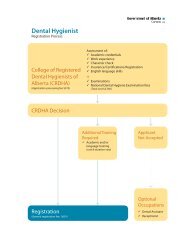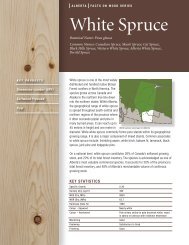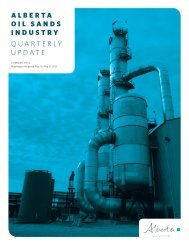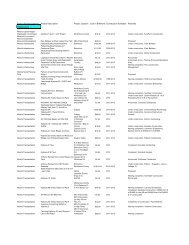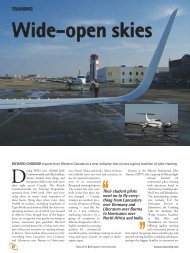Oil Sands Quarterly Winter 2013 - Alberta, Canada
Oil Sands Quarterly Winter 2013 - Alberta, Canada
Oil Sands Quarterly Winter 2013 - Alberta, Canada
You also want an ePaper? Increase the reach of your titles
YUMPU automatically turns print PDFs into web optimized ePapers that Google loves.
What’s new in the oil sands<br />
TECHNOLOGY<br />
Laricina Energy Ltd. has decided to use a cyclic process<br />
instead of conventional steam assisted gravity drainage (SAGD)<br />
in its planned commercial development of bitumen-rich<br />
carbonates in the Grosmont.<br />
To allow for the additional regulatory review time for the<br />
amended application, Laricina now estimates first steam will<br />
be injected at the Saleski project in the third quarter of 2015,<br />
pending approval. Laricina says capital costs are being reviewed<br />
to reflect the changes, but aren’t expected to exceed the<br />
previous estimate of $660 million.<br />
The project is operated and 60 per cent owned by Laricina.<br />
Osum <strong>Oil</strong> <strong>Sands</strong> Corp., another bitumen developer, owns the<br />
other 40 per cent.<br />
A new sand-control system from an <strong>Alberta</strong> manufacturer<br />
could help lower steam to oil ratios in SAGD wells. Absolute<br />
Completion Technologies Ltd. unveiled its new AimRite system<br />
during a mid-October 2012 launch at its Edmonton factory. The<br />
new system could be a boon for oilsands producers eager to<br />
improve steam to oil ratios but concerned about erosion and<br />
sand production compromising the well, the company says.<br />
AimRite—the name stands for autonomous inflow modulation—<br />
works by layering different filter media around the pipe.<br />
Numerous filter discs are drilled into the base pipe, which is<br />
then wrapped in a layer of steel wool mesh and held together<br />
by a perforated jacket. The combination allows the system to<br />
withstand higher flows of steam or liquids.<br />
However, higher temperatures carry greater risks. Should the<br />
steam break through the outer mesh and threaten the integrity<br />
of the pipe, the system shuts down, preventing serious damage.<br />
This is because the filter discs will retain produced sand,<br />
automatically blocking flow on the well and stopping erosion.<br />
ATCO Emissions Management is adding heat-recovery steam<br />
generators to its equipment lineup. In addition to power and<br />
cogeneration applications, the generators are intended for use at<br />
ALBERTA OIL SANDS INDUSTRY QUARTERLY UPDATE 7<br />
steam assisted gravity drainage production facilities, where they<br />
can be used to recover heat from a hot gas stream. Initially, the<br />
generators will be used with gas turbines up to 100 megawatts.<br />
“The adoption of the generators will allow these institutions to be<br />
‘greener’ and energy self-reliant,” says Harry Wong, senior vicepresident<br />
and general manager, ATCO Emissions Management.<br />
Cenovus Energy Inc. says it has developed a drilling rig that<br />
can be flown by helicopter to remote areas, cutting out the need<br />
to build access roads and generating cost savings of about 25<br />
per cent, or around $100 million per year.<br />
The company has been working on the technology for two<br />
years and plans to submit its research to <strong>Canada</strong>’s <strong>Oil</strong> <strong>Sands</strong><br />
Innovation Alliance as its contribution to furthering the reduction<br />
of the oil sands industry’s environmental footprint, says Harbir<br />
Chhina, Suncor’s executive vice-president of oil sands.<br />
“We don’t need to have ice bridges, things like that,” Chhina<br />
says. “At Borealis, we really couldn’t do a [stratigraphic] well<br />
drilling program unless we had 40–50 wells, because you have<br />
to trigger camps and road access. With this rig, we can drill one,<br />
two, three, 50 wells—whatever we want.”<br />
Syncrude <strong>Canada</strong> Ltd. has signed up the modular fabricator<br />
that will be working on its new tailings management project: KBR<br />
Industrial <strong>Canada</strong>.<br />
KBR will handle both module fabrication and field construction<br />
on Syncrude’s Fluid Fine Tailings – Centrifuging Full Scale Plant.<br />
Work on the modules began late in 2012 and will continue until<br />
the end of <strong>2013</strong>. Plant start-up is expected in 2015.<br />
The plant will allow Syncrude to focus on reclaiming tailings from<br />
its surface mining project near Fort McMurray, Alta. A series of<br />
centrifuges will be used to separate water from solids in fluid fine<br />
tailings. The water will be recycled for use in plant operations,<br />
while the solids will be dense enough to be deposited, capped<br />
and reclaimed.



